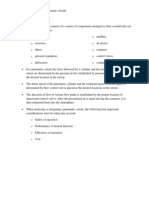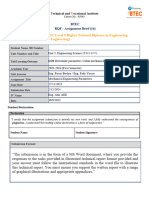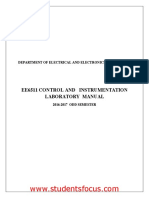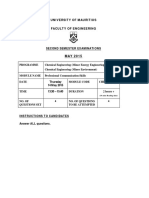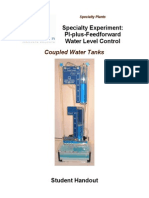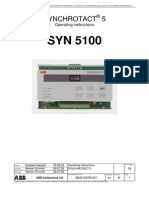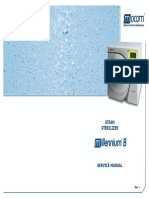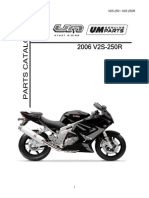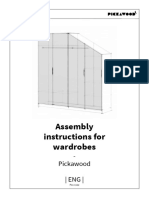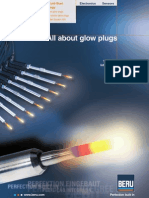User Manual: Couple Tank Experiment
User Manual: Couple Tank Experiment
Uploaded by
RUBEN DARIO TAMAYO BALLIVIANCopyright:
Available Formats
User Manual: Couple Tank Experiment
User Manual: Couple Tank Experiment
Uploaded by
RUBEN DARIO TAMAYO BALLIVIANOriginal Title
Copyright
Available Formats
Share this document
Did you find this document useful?
Is this content inappropriate?
Copyright:
Available Formats
User Manual: Couple Tank Experiment
User Manual: Couple Tank Experiment
Uploaded by
RUBEN DARIO TAMAYO BALLIVIANCopyright:
Available Formats
USER MANUAL
Couple Tank Experiment
Set Up and Configuration
CAPTIVATE. MOTIVATE. GRADUATE.
⃝
c 2012 Quanser Inc., All rights reserved.
Quanser Inc.
119 Spy Court
Markham, Ontario
L3R 5H6
Canada
info@quanser.com
Phone: 1-905-940-3575
Fax: 1-905-940-3576
Printed in Markham, Ontario.
For more information on the solutions Quanser Inc. offers, please visit the web site at:
http://www.quanser.com
This document and the software described in it are provided subject to a license agreement. Neither the software nor this document may be
used or copied except as specified under the terms of that license agreement. All rights are reserved and no part may be reproduced, stored in
a retrieval system or transmitted in any form or by any means, electronic, mechanical, photocopying, recording, or otherwise, without the prior
written permission of Quanser Inc.
Waste Electrical and Electronic Equipment (WEEE)
This symbol indicates that waste products must be disposed of separately from municipal household waste, according to Directive
2002/96/EC of the European Parliament and the Council on waste electrical and electronic equipment (WEEE). All products at the
end of their life cycle must be sent to a WEEE collection and recycling center. Proper WEEE disposal reduces the environmental
impact and the risk to human health due to potentially hazardous substances used in such equipment. Your cooperation in proper
WEEE disposal will contribute to the effective usage of natural resources. For information about the available collection and
recycling scheme in a particular country, go to ni.com/citizenship/weee.
COUPLED TANKS User Manual 2
CONTENTS
1 Presentation 4
1.1 Coupled-Tank: System Description 4
1.2 Coupled-Tank: Control Challenges 4
2 Coupled-Tanks System 7
2.1 Component Nomenclature 7
2.2 Component Description 10
3 Coupled-Tank
Model Parameters 11
4 Wiring Procedure for the Coupled-Tank System 12
4.1 Cable Nomenclature 12
4.2 Typical Connections 13
4.3 Wiring the Coupled Tanks 14
5 Configuring the Coupled-
Tank System 15
5.1 Main Water Basin 15
5.2 Flexible Tubing and Outlet Typical Setup 15
6 Water Level Sensor
Calibration 17
6.1 Calibration Circuit Board Nomenclature 17
6.2 Calibration Procedure 18
7 Technical Support 19
8 Appendix A. Quadruple-Tank Setup Procedure 20
COUPLED TANKS User Manual v 1.0
1 PRESENTATION
1.1 Coupled-Tank: System Description
The typical Coupled-Tank plant is depicted in the Figure
1.1. The Coupled-Tank specialty module is a bench-
top "Two-Tank" plant consisting of a pump with a water
basin and two tanks of uniform cross sections. Such
an apparatus forms an autonomous closed and re-
circulating system. The two tanks, mounted on the front
plate, are configured such that flow from the first (up-
per) tank can flow into the second (lower) tank. Flow
from the second tank flows into the main water reser-
voir. In each one of the two tanks, liquid is withdrawn
from the bottom through an outflow orifice (i.e. outlet).
The outlet pressure is atmospheric. Both outlet inserts
are configurable and can be set by changing inserts that
screw into the tapped holes at the bottom of each tank.
In order to introduce a disturbance flow, the first tank is
also equipped with a drain tap so that, when opened,
flow can be released directly into the water basin. The
pump thrusts water vertically to two quick-connect ori-
fices "Out1" and "Out2", which are normally closed.
For configurability purpose, these two orifices, or inlets,
have different diameters. Rubber tubing with appropri-
ate couplings is supplied to enable the pump to feed wa-
ter into one or both tanks. The selection of outputs from
the pump controls the flow ratio between the two outlets
"Out1" and "Out2". The water level in each tank is mea-
sured using a pressure-sensitive sensor located at the
bottom of the tank. As detailed later in this manual, both
offset and gain potentiometers of each pressure sensor
are readily available for proper calibration.
Additionally, a vertical scale (in centimeters) is also
placed beside each tank for visual feedback regarding
each tank's water level.This single system can be con-
figured into three main types of experiments, as listed in
Table 1.1 below. Each of which can be configured with
diverse parameter values (e.g. outlet diameters).
This single system can be configured into three main
types of experiments, as listed in Table 1.1 below. Each
of which can be configured with diverse parameter val- Figure 1.1: Coupled Tanks Plant
ues (e.g. outlet diameters).
1.2 Coupled-Tank: Control Challenges
As illustrated in Figure 1.1, the purpose of the coupled-tank experiment is to design a control system that regulates
the water level in a multiple coupled-tank system. The controller can then track the liquid level to a desired trajectory.
The system is supplied with different feedback-plus-feedforward controllers tuned through pole placement but, of
COUPLED TANKS User Manual 4
course, you may design any other controller you wish. The complete mathematical modelling and system parameters
are provided to streamline the implementation of the control theory of your choice. A single Coupled-Tank system
can be configured into three types of experiments, as illustrated and described in Table 1.1, below. Each of the
resulting control challenges can then be configured with various system parameters.
Configuration #1 Configuration #2 Configuration #3
Single Input Single Output State-coupled SISO system. State-coupled and input-coupled
(SISO) system. SISO system.
The pump feeds into Tank 1. The pump feeds into Tank 1, The pump feeds into Tank 1 and
Tank 2 is not used at all. which in turn feeds into Tank 2. into Tank 2 using a split flow.
Tank 1 also feeds into Tank 2
A controller is designed to regu- A controller is designed to regu- A controller is designed to regu-
late or track the level in Tank 1. late or track the level in Tank 2. late or track the level in Tank 2.
Different inlet and outlet diame- Different inlet and outlet diame- Different inlet and outlet diame-
ters in Tank 1 can be set up and ters in Tank 1 and Tank 2 can be ters in Tank 1 and Tank 2 can be
tried. set up and tried. set up and tried.
(a) Configuration #1 (b) Configuration #2 (c) Configuration #3
Table 1.1: Coupled-Tank Water Level Control Configuration
Additionally, two Two-Tank plants can also be used simultaneously and coupled to obtain more complex Multi-Input-
Multi-Output (MIMO) experiment. For example, Figure 1.2 below illustrates the quadruple-tank process described
in the following publication: K. H. Johansson. The Quadruple-Tank Process: A Multivariable Laboratory Process
with an Adjustable Zero. IEEE Transactions on Control Systems Technology, 8(3):456-465, 2000 ([?]) Appendix A
describes how to setup two Coupled-Tank systems to be used in a quadruple-tank experiment. It can be shown that
the four-interconnected-tank system has an adjustable zero, which can be moved along the real axis in the left- or
right-hand-side of the s-plane. Therefore by changing the system parameters, the multivariable zero dynamics can
be configured to be either minimum phase or non-minimum phase.
Caution: This equipment is designed to be used for educational and research purposes and is not
intended for use by the general public. The user is responsible to ensure that the equipment
will be used by technically qualified personnel only.
COUPLED TANKS User Manual v 1.0
Figure 1.2: Quadruple-Tank System consisting of two Coupled-Tank Plants
COUPLED TANKS User Manual 6
2 COUPLED-TANKS SYSTEM
2.1 Component Nomenclature
As a quick nomenclature, Table 2.1, below, provides a list of all the principal elements composing the Coupled-
Tank Specialty system. Every element is located and identified, through a unique identification (ID) number, on the
Coupled-Tank plant represented in Figure 2.1, Figure 2.2 and Figure 2.3, below.
ID Component ID Component
1 Coupled-Tank Overall Frame 12 Medium Outlet Insert (9/16" Hexagonal Nut)
2 Tank 1 13 Large Outlet Insert (9/16" Hexagonal Nut)
3 Tank 2 14 Plain Outlet Insert (i.e. Plug)(9/16" Hexagonal Nut)
4 Main Water Basin (a.k.a. Reservoir) 15 Disturbance Tap
5 Pump 16 Flow Splitter
6 Flexible Tubing (in rubber) 17 Pressure Sensor
7 Quick-Connect Inlet Orifice "Out1" 18 Calibration And Signal Conditioning Circuit Board
8 Quick-Connect Inlet Orifice "Out2" 19 Pump Motor 4-Pin DIN Connector
9 Quick-Connect "Out1" Coupling And Hose 20 Pressure Sensors Cable 6-Pin-Mini-DIN Connector
10 Quick-Connect "Out2" Coupling And Hose 21 Tank Level Scale (in cm)
11 Small Outlet Insert (9/16" Hexagonal Nut)
Table 2.1: Coupled-Tank Component Nomenclature
COUPLED TANKS User Manual v 1.0
(a) Front (b) Back
Figure 2.1: Front Back and Base of the Coupled Tank
COUPLED TANKS User Manual 8
Figure 2.2: Base of the Coupled Tank
(a) Quick-Connect "Out1" (b) Quick-Connect "Out2"
Figure 2.3: Quick Connect Couplings
COUPLED TANKS User Manual v 1.0
2.2 Component Description
2.2.1 Overall Frame (Component #1)
The Coupled-Tank overall frame is made of Plexiglas. Its external dimensions are shown in Table 2.2, below.
Description Value Unit
Overall Frame Height 0.915 m
Overall Frame Width 0.305 m
Overall Frame Depth 0.305 m
Table 2.2: Coupled-Tank Frame Overall Dimensions
2.2.2 Tanks (Component #2 and #3)
The system's two water tanks are made out of Plexiglas tubes of uniform cross section.
2.2.3 Pump (Component #5)
The Coupled-Tank pump is a gear pump composed of a DC motor rated for 12 V continuous and 22 V peak with
heat radiating fins. The materials that come into contact with the fluid being pumped are: two molded Delrin gears
in a Delrin pump body, stainless steel shafting, a Teflon diaphragm and a Buna N seal. It is also equipped with 3/16"
ID hose fittings.
Caution: Input +/- 24 V, 5 A peak, 3 A continuous.
2.2.4 Pressure Sensor (Component #17)
Each tank's actual liquid level is measured through a pressure sensor. Such a level sensor is located at the bottom
of each tank and provides linear level readings over the complete liquid vertical level. In other words, the sensor
output voltage increases proportionally to the applied pressure. Its output measurement is processed through a
signal conditioning board (component #18) and made available as 0 to 5V DC signal. Its measurement sensitivity
is given in Table 3.1, below. Moreover, as detailed in a following section, calibration of each pressure sensor's
offset and gain potentiometers is required to keep level measurements consistent with the type of liquid used in the
coupled-tank experiment.
Caution: Make sure the circuit board (component #18) does not get wet.
Caution: Depending on the duration of your experiment, the pump might get hot.
COUPLED TANKS User Manual 10
3 COUPLED-TANK
MODEL PARAMETERS
Table 3.1, below, lists and characterizes the main parameters (e.g. mechanical and electrical specifications, con-
vertion factors, constants) associated with the two-tank specialty plant. Some of these parameters can be used
for mathematical modelling of the Coupled-Tank system as well as to obtain the water level's Equation Of Motion
(EOM).
Symbol Description Value Unit
KP Pump Flow Constant 3.3 cm3 /s/V
VP max Pump Maximum Continuous Voltage 12 V
VP peak Pump Peak Voltage 22 V
DOut1 Out 1 Orifice Diameter 0.635 cm
DOut2 Out 2 Orifice Diameter 0.47625 cm
L1max Tank 1 Height (i.e. Water Level Range) 30 cm
Dt1 Tank 1 Inside Diameter 4.445 cm
KL1 Tank 1 Water Level Sensor Sensitivity (Depending on the 6.1 cm/V
Pressure Sensor Calibration).
L2max Tank 2 Height (i.e. Water Level Range) 30 cm
KL2 Tank 2 Water Level Sensor Sensitivity (Depending on the 6.1 cm/V
Pressure Sensor Calibration).
L2max Tank 2 Height (i.e. Water Level Range) 30 cm
Vbias Tank 1 and Tank 2 Pressure Sensor Power Bias +/-12 V
Prange Tank 1 and Tank 2 Sensor Pressure Range 0 - 6.89 kPa
DSo Small Outflow Orifice Diameter 0.31750 cm
DM o Medium Outflow Orifice Diameter 0.47625 cm
DLo Large Outflow Orifice Diameter 0.55563 cm
g Gravitational Constant on Earth 981 cm/s2
Table 3.1: Coupled-Tank System Model Paremeters
COUPLED TANKS User Manual v 1.0
4 WIRING PROCEDURE FOR THE
COUPLED-TANK SYSTEM
This section describes the standard wiring procedure for the Coupled-Tank specialty plant. The following hardware,
accompanying the Coupled Tanks, is assumed:
1. Power Amplifier: Quanser VoltPAQ, or equivalent
2. Data Acquisition Board: Quanser Q2-USB, Quanser Q1-cRIO, Q8-USB, QPID, or equivalent.
4.1 Cable Nomenclature
Table 4.1, below, provides a description of the standard cables used in the wiring of the Coupled-Tank system.
Cable Type Description
2xRCA to 2xRCA This cable connects an analog output of the
Data Acquisition (DAQ) Device to the power
module for proper power amplification.
(a) RCA Cable
4-pin-DIN to 6-pin- This cable connects the output of the power
DIN module, after amplification, to the desired ac-
tuator (e.g. gear pump).
(b) "To Load" Cable
6-pin-mini-DIN to This cable carries analog signals from one
6-pin-mini-DIN or two plant sensors (e.g. pressure sensors)
to the amplifier, where the signals can be ei-
ther monitored and/or used by an analog con-
troller. The cable also carries a ±12VDC line
(c) "From Analog Sensors"
from the amplifier in order to power a sensor
Cable and/or signal conditioning circuitry.
5-pin-DIN to This cable carries the analog signals, previ-
4xRCA ously taken from the plant sensors (e.g. pres-
sure sensors), unchanged, from the amplifier
to the Digital-To-Analog input channels on the
Data Acquisition (DAQ) Device.
(d) Analog-To-Digital" Cable
Table 4.1: Cable Nomenclature
COUPLED TANKS User Manual 12
4.2 Typical Connections
Table 4.2, below, sums up the electrical connections necessary to run the Coupled-Tank system.
Caution: If you are using the Quanser VoltPAQ, make sure the gain on the amplifier is set to 3!
Cable From To Signal
#
1 Analog Output AO #0 Amplifier "Command" connector Control signal to the amplifier.
2 Amplifier To Load con- Coupled-Tank's "Pump Connector" Power leads to the gear pump.
nector connector
3 Amplifier "To ADC" Data Acquisition (DAQ) Device: Tank 1 and tank 2 level feedback sig-
nals to the Data Acquisition (DAQ) De-
1. S1 (yellow) to Analog Input AI #0 vice, through the amplifier.
2. S2 (white) to Analog Input AI #1
4 Coupled-Tank's "Pres- Amplifier "S1 & S2" Liquid level feedback signal to the am-
sure Sensors Connector" plifier.
#1
5 Power Supply Outlet #1 Amplifier Power Socket Amplifier Power Supply.
Table 4.2: Coupled-Tank Wiring Summary
Figure 4.1 shows the Data Acquisition Device, the back of the Coupled-Tank plant, and the amplifier, all connected
with the necessary cabling to interface to and use the Coupled-Tank plant.
Figure 4.1: Coupled Tank Wiring Diagram
COUPLED TANKS User Manual v 1.0
4.3 Wiring the Coupled Tanks
1. Connect the "RCA Cable" #1:
Using the "RCA cable" cable described in Table 4.1, connect one end of this cable to the Analog Output
0(i.e. AO # 0) of your Data Acquisition (DAQ) Device and its other corresponding side to the socket labelled
"Command" on the amplifier. These two connections are illustrated by cable #1 in Figure 4.1.
2. Connect the "To Load" Cable #2:
The "To Load" cable is the 4-pin-DIN-to-6-pin-DIN cable described in Table 4.1. First, connect the cable 4-
pin-DIN connector to the Coupled-Tank's Pump connector, which is shown as component #19 in Figure 2.1b
and Figure 2.1a. Then connect the cable 6-pin-DIN connector to the amplifier socket labelled "To Load". The
connection to the amplifier is illustrated by cable # 2 in Figure 4.1
3. Connect the "Analog-To-Digital" Cable #3:
The "To Analog-To-Digital" cable is the 5-pin-DIN-to-4xRCA cable described in Table 4.1. First, connect the
cable 5-pin-DIN connector to the amplifier socket labelled "To ADC", as illustrated by cable #3 in Figure 4.1.
The other end of the cable is split into four RCA connectors (yellow, white, red and black). This four RCA
connectors correspond to the analog sensor signals passing through the amplifier, namely S1-yellow, S2-
white, S3-red and S4-black. In order for the analog signals to be used in software, you should then connect
the RCA connectors to the analog input channels of your Data Acquisition (DAQ) Device. Specifically, connect
S1 (yellow) to Analog Input 0 and S2 (white) to Analog Input 1, S3 (red) and S4 (black) are not used in
this experiment, but you can connect them to Analog Inputs 2 and 3 of your acquisition card terminal board, if
it has that capability. See cable #3 in Figure 4.1.
4. Connect the "From Analog Sensors" Cable #4:
The "From Analog Sensors" cable is the 6-pin-mini-DIN-to-6-pin-mini-DIN cable described in Table 4.1. First
connect one end of the cable to the Pressure Sensors Connector, located at the back of the Coupled-Tank
and which is shown as component #20 in Figure 2.1b. Then connect the cable's other end to the amplifier
socket labelled "S1 & S2", which is contained inside the amplifier "From Analog Sensors" front panel. These
connections are illustrated by cable #4 in Figure 4.1.
In other words, the liquid level in tank 1 is sensed using A/D #0 through the amplifier analog channel S1, and the
liquid level in tank 2 is sensed using A/D #1 through the amplifier analog channel S2.
Caution: If the equipment is used in a manner not specified by the manufacturer, the protection provided by
the equipment may be impaired.
COUPLED TANKS User Manual 14
5 CONFIGURING THE COUPLED-
TANK SYSTEM
5.1 Main Water Basin
1. Fill the Coupled-Tank water basin up to 3/4 of its height.
2. Insert the basin inside the bottom of the Coupled-Tank frame, as illustrated in Figure 2.2
3. Ensure that the pump inflow flexible tube is located inside the water basin.
4. Setup the configuration 1, 2, or 3. Table 5.1 details the inlet and outlet sizes for the three standard configura-
tions.
Note: It is recommended to use distilled water (i.e. without mineral salts) to fill up the main basin. This is to avoid
stains on the system's Plexiglas tubes and structure as the water dries out.
5.2 Flexible Tubing and Outlet Typical Setup
As previously mentioned, a single Coupled-Tank system can be configured into three different types of experiments,
corresponding to the system's configurations #1, #2, and #3 as illustrated and described in Table 1.1, above. Each
configuration results in a distinct control challenge and can also be modified by using different values for the system
parameters. However, the default water level controllers supplied with the Coupled-Tank plant have been designed
for the standard three system's configurations described hereafter.
A system configuration is defined in terms of each tank inflow and outflow characteristics, as well as the desired
control variable. Table 5.1, below, details the Coupled-Tank setup for the three standard configurations.
Configuration #1 Configuration #2 Configuration #3
Tank 1 Inflow From "Out 1". From "Out 1" From "Out 1"
Tank 1 Outlet Insert Size Medium Medium. Small
Tank 2 Inflow From Tank 1 Outflow. From Tank 1 Outflow. From Tank 1 Outflow and
From "Out 1"
Tank 2 Outlet Insert Size Medium. Medium. Large .
Control Variable Tank 1 Level Tank 2 Level Tank 2 Level
Table 5.1: Coupled-Tank Default Setup For Configurations #1, #2, and #3
In other words, Table 5.1, above, indicates the appropriate exit orifice and the appropriate feed from the pump to
use for the three configurations corresponding to different experiments.
For all three configurations make sure:
1. The disturbance tap, directly connecting tank 1 to the main water basin, is closed.
2. The drain tap is identified by component #15 in Figure 2.1a and Figure 2.2, above. For the tap to be closed,
its flap should be horizontal.
3. Configuration 1 and 2 Figure 5.1a, illustrates the Coupled-Tank system setup in configurations #1 and #2.
Note that the quick-connect "Out 1" coupling and flexible hose, depicted by component #9, is used to transport
the water from the inlet orifice "Out 1" to Tank 1.
COUPLED TANKS User Manual v 1.0
(a) Coupled-Tank Configurations #1 and #2 (b) Coupled-Tank Configurations #3
Figure 5.1: Configurations 1, 2 and 3
4. Configuration 3 Figure 5.1b, illustrates the Coupled-Tank system setup in configuration #3. This time note
that the quick-connect "Out 1" coupling and flexible hose, depicted by component #9, is used to transport the
water from the inlet orifice "Out 1" to Tank 2. Similarly, the quick-connect "Out 2" coupling and flexible hose,
depicted by component #10, is used to transport the water from the inlet orifice "Out 2" to Tank 1.
Note: When putting the output tube from the pump into the water tank, ensure that the water discharge to the water
column occurs at atmospheric pressure. In other words, the hose tip should stand above the tank water level (e.g.
above the 25-cm mark).
COUPLED TANKS User Manual 16
6 WATER LEVEL SENSOR
CALIBRATION
The pressure-proportional water level voltage should be zero when the tank is empty, while it should be between
4.0 Volts and 4.2 Volts when the tank water level is at 25 centimeters (as seen on the tank scale).
Note: The pressure-sensitive water level sensor is calibrated at the factory but may need re-adjustment when you
receive it, or under different water characteristics (depending on the kind of liquid used).
6.1 Calibration Circuit Board Nomenclature
To calibrate both pressure sensors signals, the bottom part of the Coupled-Tank apparatus houses a signal condi-
tioning circuit board, depicted by component #18 in Figure 2.1, above. As a quick nomenclature, Table 6.1, below,
provides a list of the different signal conditioning potentiometers to be tuned during sensors calibration. Addition-
ally, every potentiometer is located and identified, through a unique identification (ID) number, on the circuit board
close-up represented in Figure 6.1, below.
ID Component
23 Tank 1 Sensor Offset Potentiometer
24 Tank 1 Sensor Gain Potentiometer
25 Tank 2 Sensor Offset Potentiometer
26 Tank 2 Sensor Gain Potentiometer
Table 6.1: Coupled-Tank Component Nomenclature
Figure 6.1: Coupled-Tank Calibration Potentiometer
COUPLED TANKS User Manual v 1.0
6.2 Calibration Procedure
The calibration procedure detailed in the following subsections is to calibrate the circuit board's four potentiometers,
which are namely "Offset 1", "Gain 1", "Offset 2", and "Gain 2", as depicted in Figure 6.1, above, as components
#23, #24, #25, and #26, respectively.
In order to successfully run the calibration procedure:
1. Ensure that the Coupled-Tank system is wired as previously described.
2. Setup the Coupled-Tank apparatus to configuration #2 with the appropriate exit orifices and the appropriate
feed from the pump, as previously summarized in Table 5.1 and illustrated in Figure 5.1a, above.
3. Power up the amplifier, you are now ready to proceed.
Note: Make sure the flexible tube from "Out 1" is inserted into tank 1. Do not connect a tube to "Out 2".
6.2.1 Zero "Offset" Potentiometer Calibration: With No Wa-
ter
To calibrate the offset to zero to 0V for both tank pressure sensor readings do the following:
1. Ensure the Pump is OFF and tank is empty.
2. Run the supplied calibration software files keeping the Pump OFF.
3. Measure tank #1 voltage on Analog Input Channel #0. For tank #2, use Analog Input Channel #1.
4. Adjust the pots using a potentiometer adjustment tool (i.e. a small flat-end screwdriver), manually adjust tank
1 Offset potentiometer screw (i.e. components #23 and #25), if necessary, in order to obtain 0.0 Volts for both
readings. Turning the Offset potentiometer screw clockwise increases the voltage and vice-versa.
5. This Voltage can be monitored in the display found in the calibration software.
When both zero-Volt offsets are achieved, you can move on the next section to calibrate the gain potentiometers.
6.2.2 "Gain" Potentiometer Calibration: At a 25-cm Water
Level
The calibration of each one of the two gain potentiometers is performed with the corresponding tank containing water
up to the 25-centimeter scale mark.
1. Fill up the water tank to the 25 cm mark. Plug the tank 1 outlet with your finger and apply a pump voltage using
the supplied calibration software files.
2. When the 25-centimeter level mark is attained, stop the pump feed.
3. Measure tank #1 voltage on Analog Input Channel #0. For tank #2, use Analog Input Channel #1.
4. Using a potentiometer adjustment tool (i.e. a small flat-end screwdriver), manually adjust tank 1 gain poten-
tiometer screw (i.e. component #24 in Figure 6.1 ) to obtain anywhere between 4.0 and 4.2 Volts. Turning
the gain potentiometer screw clockwise increases the voltage and vice-versa.
5. This Voltage can be monitored in the display found in the calibration software.
Repeat procedure to tank 2.
COUPLED TANKS User Manual 18
7 TECHNICAL SUPPORT
To obtain support from Quanser, go to http://www.quanser.com/ and click on the Tech Support link. Fill in the form
with all the requested software and hardware information as well as a description of the problem encountered. Also,
make sure your e-mail address and telephone number are included. Submit the form and a technical support person
will contact you.
Note: Depending on the situation, a support contract may be required to obtain technical support.
COUPLED TANKS User Manual v 1.0
8 APPENDIX A. QUADRUPLE-TANK
SETUP PROCEDURE
Figure 8.1 shows a generic Data Acquisition (DAQ) Device, the back of the Quadruple-Tank plant, and the amplifier,
all connected with the necessary cabling to interface to and use the Quadruple-Tank plant.
Figure 8.1: Quadruple Tank Wiring Diagram.
COUPLED TANKS User Manual 20
Table 8.1 sums up the electrical connections necessary to run the Quadruple-Tank system.
Cable From To Signal
#
1 Analog Output AO #0 Amplifier 1 "Command" connector Control signal to the amplifier.
2 Amplifier 1 To Load con- Coupled-Tank's "Pump" connector Power leads to the gear pump.
nector
3 Amplifier 1 "To ADC" Data Acquisition (DAQ) Device: Tank 1 and tank 2 level feedback
signals to the Data Acquisition
1. S1 (yellow) to Analog Input AI #0 (DAQ) Device, through the am-
plifier.
2. S2 (white) to Analog Input AI #1
4 Coupled-Tank's "Pres- Amplifier 1 "S1 & S2" Liquid level feedback signal to
sure Sensors" Connector the amplifier.
#1
5 Analog Output AO #1 Amplifier 2 "Command" connector Control signal to the amplifier.
6 Amplifier 2 To Load con- Coupled-Tank's "Pump" Connector Power leads to the gear pump.
nector
7 Amplifier 2 "To ADC" Data Acquisition (DAQ) Device Tank 3 and tank 4 level feedback
signals to the Data Acquisition
1. S1 (yellow) to Analog Input AI #3 (DAQ) Device, through the am-
plifier.
2. S2 (white) to Analog Input AI #4
8 Coupled-Tank's "Pres- Amplifier 1 "S1 & S2" Liquid level feedback signal to
sure Sensors Connector" the amplifier.
Power Supply Outlet #1 Amplifier Power Socket Amplifier Power Supply.
Power Supply Outlet #2 Amplifier Power Socket Amplifier Power Supply.
Table 8.1: Quadruple-Tank Wiring Summary
A system configuration is defined in terms of each tank inflow and outflow characteristics, as well as the desired
control variable. Table 5.1 details the Coupled-Tank setup for the three standard configurations, whereas Table
8.2 indicates the appropriate exit orifice and the appropriate feed from the pump to use for the Quadruple-tank
configuration.
Note: Ensure that the disturbance tap, directly connecting tank 1 and 3 to the main water basin, is closed. The
drain tap is identified by component #15 in Figure 2.1a and Figure 2.2. For the tap to be closed, its flap should be
horizontal.
Configuration #4
Tank 1 Inflow From "Out 1" of Pump 1
Tank 1 Outlet Insert Size Medium
Tank 2 Inflow From Tank 1 Outflow.
Tank 2 Outlet Insert Size Medium
Control Variable Tank 2 and 4 Level
Tank 3 Inflow From "Out 1" of Pump 2
Tank 3 Outlet Insert Size Medium
Tank 4 Inflow From Tank 3 Outflow
Tank 4 Outlet Insert Size Medium
Table 8.2: Coupled-Tank Default Setup for Configurations #4
COUPLED TANKS User Manual v 1.0
Full range of process control and mechatronic control
plants for teaching and research
Coupled Tank Heatflow Experiment Solar Tracker
Magnetic Levitation Laser Beam Stabilizer
These five plants allow you to study or research traditional and modern applications
including laser stabilization, sensors and solar tracking. For more information please
contact info@quanser.com
©2012 Quanser Inc. All rights reserved.
INFO@QUANSER.COM +1-905-940-3575 QUANSER.COM
Solutions for teaching and research. Made in Canada.
You might also like
- Manual York ACDocument35 pagesManual York ACjamil670100% (1)
- Bus Data ListDocument28 pagesBus Data ListCinaAutopartsNo ratings yet
- Power Plants Automation and Control Using PLC TehnDocument5 pagesPower Plants Automation and Control Using PLC TehnAnonymous mNQq7ojNo ratings yet
- Sem2 Mechatronics Labsheet PDFDocument18 pagesSem2 Mechatronics Labsheet PDFJovan MitrevskiNo ratings yet
- ABB Installation ContactorsDocument20 pagesABB Installation ContactorsGILBERTO ALTUNARNo ratings yet
- MEM 341 - Chapter 13 Pneumati CircuitDocument14 pagesMEM 341 - Chapter 13 Pneumati CircuitMuhammad AbdullahNo ratings yet
- Verification of Thevenin's Theorem: Case 1 Case 2 (A) Case 2 (B)Document2 pagesVerification of Thevenin's Theorem: Case 1 Case 2 (A) Case 2 (B)Himanshu JindalNo ratings yet
- Programmable Controller: ECEA103-1L B6Document4 pagesProgrammable Controller: ECEA103-1L B6Michael AlanoNo ratings yet
- Chapter 3 Nodal and Mesh Equations - Circuit Theorems 3.14 ExercisesDocument45 pagesChapter 3 Nodal and Mesh Equations - Circuit Theorems 3.14 ExercisesRitchie Quinto DE TorresNo ratings yet
- PLC - HMI Lab #4 22W1Document2 pagesPLC - HMI Lab #4 22W1crazyjmprNo ratings yet
- S7 Solution Provider Test S7Pr - Px7Document4 pagesS7 Solution Provider Test S7Pr - Px7Chakib AutomationNo ratings yet
- Experiment No. 1 NewDocument24 pagesExperiment No. 1 NewAamna KhalidNo ratings yet
- Colorado School of Mines CHEN403: 1 Where MinDocument12 pagesColorado School of Mines CHEN403: 1 Where MinpoopoophoNo ratings yet
- EE 21 25 ReportDocument8 pagesEE 21 25 ReportAraNo ratings yet
- SIMATIC S7 S7-1200 Programmable Controller General Specifications and FeaturesDocument14 pagesSIMATIC S7 S7-1200 Programmable Controller General Specifications and Featuresheryka LayseNo ratings yet
- PID Control of Water Level in A Coupled Tank SystemDocument9 pagesPID Control of Water Level in A Coupled Tank SystemEioAsan100% (1)
- Enginering Science - Assignment (2) LOs 2Document11 pagesEnginering Science - Assignment (2) LOs 2Mohamed AlaaNo ratings yet
- s71200 Easy Book en-US en-USDocument304 pagess71200 Easy Book en-US en-USAli Özkan KayaNo ratings yet
- EE6511-Control and Instrumentation Laboratory - 2013 - RegulationDocument98 pagesEE6511-Control and Instrumentation Laboratory - 2013 - Regulationmokshagna saitejaNo ratings yet
- How To Configure EtherNet-IP Coupler Unit PDFDocument8 pagesHow To Configure EtherNet-IP Coupler Unit PDFfaspNo ratings yet
- Lab 1: SFC: BackgroundDocument20 pagesLab 1: SFC: BackgroundAntonio GodoyNo ratings yet
- PLC Lab #4 Event SequencingDocument15 pagesPLC Lab #4 Event SequencingIan SpacekNo ratings yet
- SM331 Getting Started Teil3 eDocument70 pagesSM331 Getting Started Teil3 eTrung MaiNo ratings yet
- OP AMP NotesDocument31 pagesOP AMP NotesEbonguko ClintonNo ratings yet
- 06 Programmable Logic Controller PracticalDocument3 pages06 Programmable Logic Controller PracticalAnkitNo ratings yet
- Technical Slides TIA Portal V15 enDocument46 pagesTechnical Slides TIA Portal V15 enTonheca RockkNo ratings yet
- University of Mauritius: (10 Mins Reading Time)Document3 pagesUniversity of Mauritius: (10 Mins Reading Time)Keshav GopaulNo ratings yet
- Mahmoud Safwat 221010842 PEARSON BTEC Proposal +research Ethics Approval + Performance Review FormsDocument9 pagesMahmoud Safwat 221010842 PEARSON BTEC Proposal +research Ethics Approval + Performance Review Formsm2277moudNo ratings yet
- Lab No 7 - Introduction To Electro PneumaticsDocument4 pagesLab No 7 - Introduction To Electro PneumaticsMuhammad RafayNo ratings yet
- QS Practice (QS RQF) Assignment - S3 2021Document6 pagesQS Practice (QS RQF) Assignment - S3 2021Nuwantha Lakpriya100% (1)
- Ziegler-Nichols Tuning Method: Understanding The PID ControllerDocument13 pagesZiegler-Nichols Tuning Method: Understanding The PID ControllerSaran SelvanNo ratings yet
- Hang Hy Van 19ed10130 Arplc AsmDocument30 pagesHang Hy Van 19ed10130 Arplc Asmvan hangNo ratings yet
- Assignment Brief and Feedback - Assignment3 - Unit22 (LO3 Oscillators) RevA - V1.2Document5 pagesAssignment Brief and Feedback - Assignment3 - Unit22 (LO3 Oscillators) RevA - V1.2Davide JonesNo ratings yet
- Project Report of Laser Security Alarm SystemDocument25 pagesProject Report of Laser Security Alarm SystemB LIKHITH KUMARNo ratings yet
- Microcontrollers Notes For IV Sem ECE StudentsDocument19 pagesMicrocontrollers Notes For IV Sem ECE StudentsVigneshwar DhamodharanNo ratings yet
- Lab Manual MechatronicsDocument50 pagesLab Manual MechatronicsBala ChandarNo ratings yet
- Control of Continuous Process: Lecturer: Dr. Shallon StubbsDocument32 pagesControl of Continuous Process: Lecturer: Dr. Shallon StubbsLuther King Ferguson100% (1)
- تجارب مخبر الهيدروليك طالبDocument150 pagesتجارب مخبر الهيدروليك طالبjndalyfrasNo ratings yet
- Monitoring and Diagnostics of PV Plants by A Wireless Self-Powered Sensor For Individual PanelsDocument9 pagesMonitoring and Diagnostics of PV Plants by A Wireless Self-Powered Sensor For Individual PanelsDevil faNo ratings yet
- FL Sim p4-6Document369 pagesFL Sim p4-6pauloghunterNo ratings yet
- Manualfluidsimeng PDFDocument277 pagesManualfluidsimeng PDFRevilo OrtegaNo ratings yet
- Transducer and Their ClassificationDocument2 pagesTransducer and Their ClassificationPujaChaudhuryNo ratings yet
- PLC, Hmi and Scada Training - 240724 - 173925Document37 pagesPLC, Hmi and Scada Training - 240724 - 173925Mian awais ChNo ratings yet
- PLC AppppppDocument20 pagesPLC AppppppErsanAhmedNo ratings yet
- SKEM 3742 Electro Hydraulic LabsheetDocument6 pagesSKEM 3742 Electro Hydraulic Labsheetcikgu_relaNo ratings yet
- ELE 374 Lab ReportDocument34 pagesELE 374 Lab Reportec09364100% (1)
- MMS4.0 Project02 Station2 en LH 28042016Document10 pagesMMS4.0 Project02 Station2 en LH 28042016khairul fahmiNo ratings yet
- Simulation of Automatic Water Level Control System by Using Programmable Logic ControllerDocument8 pagesSimulation of Automatic Water Level Control System by Using Programmable Logic ControllerEditor IJTSRDNo ratings yet
- Lab 2 RLC CircuitDocument12 pagesLab 2 RLC CircuitJustin WesleyNo ratings yet
- Material Testing Lab ManualDocument34 pagesMaterial Testing Lab ManualYogeswaranNo ratings yet
- S7-300 Module Data - Analog IO Module SM 334Document7 pagesS7-300 Module Data - Analog IO Module SM 334dragon_tudvnNo ratings yet
- Simple PLC Program To Control MixerDocument15 pagesSimple PLC Program To Control Mixermaulana hasanudin asy'ariNo ratings yet
- infoPLC Net 109822788 SIMATICRobotPickAIURAppExample DOC EN V10Document47 pagesinfoPLC Net 109822788 SIMATICRobotPickAIURAppExample DOC EN V10faspNo ratings yet
- Certified Automation Engineer (CAE) : SyllabusDocument4 pagesCertified Automation Engineer (CAE) : SyllabusSMEClabsNo ratings yet
- Design of Remote Electro-Pneumatic Control System Using MicrocontrollerDocument16 pagesDesign of Remote Electro-Pneumatic Control System Using MicrocontrollerRasha KaNo ratings yet
- Coupled Tanks - User ManualDocument22 pagesCoupled Tanks - User Manualpinkpanter100% (1)
- 5.raw Water SystemDocument7 pages5.raw Water Systempepenapao1217No ratings yet
- Manual For The Distillation Column: Jørgen K. Johnsen June 21, 2005Document12 pagesManual For The Distillation Column: Jørgen K. Johnsen June 21, 2005Abdul Gafoor ShaikhNo ratings yet
- Manual - E4 - E4le - EZ4 Water Purif PDFDocument27 pagesManual - E4 - E4le - EZ4 Water Purif PDFintermountainwaterNo ratings yet
- 07 Hydronic Systems App 1Document12 pages07 Hydronic Systems App 1scarpredator5No ratings yet
- Coupled TanksDocument32 pagesCoupled TanksbgizachewNo ratings yet
- Winter 2018-2019 Solutions: EE368/CS232 Digital Image ProcessingDocument25 pagesWinter 2018-2019 Solutions: EE368/CS232 Digital Image ProcessingRUBEN DARIO TAMAYO BALLIVIANNo ratings yet
- Nanotubos de CarbonDocument60 pagesNanotubos de CarbonRUBEN DARIO TAMAYO BALLIVIANNo ratings yet
- Recommended Selection Charts-EasyPact TVS - V20 - 20 - 06 - 2019Document20 pagesRecommended Selection Charts-EasyPact TVS - V20 - 20 - 06 - 2019RUBEN DARIO TAMAYO BALLIVIANNo ratings yet
- FPGA and FPGAC (High Level Synthesise Tools)Document15 pagesFPGA and FPGAC (High Level Synthesise Tools)RUBEN DARIO TAMAYO BALLIVIANNo ratings yet
- Brochure Presssysteme Int NetDocument28 pagesBrochure Presssysteme Int NetgkpNo ratings yet
- Sinkrotakt Manual 5Document39 pagesSinkrotakt Manual 5Vlado RadojsolicNo ratings yet
- User Guide Terrameter LS 2016 03 14 1 PDFDocument124 pagesUser Guide Terrameter LS 2016 03 14 1 PDFYENY HERNANDEZNo ratings yet
- Instruction Manual For AC Generators EnglishDocument60 pagesInstruction Manual For AC Generators EnglishAlexNo ratings yet
- Stralis: LNG System - Requirements For LNG Refilling ST AtionDocument12 pagesStralis: LNG System - Requirements For LNG Refilling ST AtionVilas AndhaleNo ratings yet
- C K4SD Manual Jan.2021Document8 pagesC K4SD Manual Jan.2021RadNo ratings yet
- Manual Chorus TitleyDocument48 pagesManual Chorus TitleyIvan De la CruzNo ratings yet
- Autoclave Millennium BDocument285 pagesAutoclave Millennium BTarekNo ratings yet
- BGA Service ManualDocument55 pagesBGA Service ManualAnonymous Cd6vh0VyhtNo ratings yet
- Datasheet-AM 400 V1.1Document16 pagesDatasheet-AM 400 V1.1Ganesan SelvamNo ratings yet
- HM41X ManualDocument92 pagesHM41X ManualbjlkstNo ratings yet
- Muwa037-231 30594839Document128 pagesMuwa037-231 30594839NakaTomiNo ratings yet
- United Motors V2S 250ccDocument126 pagesUnited Motors V2S 250ccAna Mabel GuevaraNo ratings yet
- Instructional Manual Wardrobe With Table of ContentsDocument24 pagesInstructional Manual Wardrobe With Table of ContentsChristian LidanNo ratings yet
- Candy FCP 602 X-ch64ccbDocument32 pagesCandy FCP 602 X-ch64ccbSanitarije SNo ratings yet
- Soldering ToolsDocument7 pagesSoldering ToolsThamilselvan VengatasalamNo ratings yet
- Guide For Installation of Solar PV SystemsDocument26 pagesGuide For Installation of Solar PV SystemsChris ParkinsonNo ratings yet
- 556U Immobolizer InterfaceDocument9 pages556U Immobolizer InterfaceLuis Perez100% (1)
- All Ablut Glowplugs BERUDocument16 pagesAll Ablut Glowplugs BERURoman AdamNo ratings yet
- Iveco Daily 2000my Repair ManualDocument20 pagesIveco Daily 2000my Repair Manualhelen98% (64)
- Kozii Instruction Manual V3Document2 pagesKozii Instruction Manual V3DanielMenesesMancillaNo ratings yet
- TVL CSS 4TH Module FinalDocument26 pagesTVL CSS 4TH Module FinalHilton D. CalawenNo ratings yet
- User Manual. Aplisens Pressure Transmiters. APC-2000ALW SafetyDocument44 pagesUser Manual. Aplisens Pressure Transmiters. APC-2000ALW SafetyGermán SuchanNo ratings yet
- SW70A1 Service ManualDocument35 pagesSW70A1 Service ManualAdi AdiyantoNo ratings yet
- (E) 40XMH'13 E40xwh'13 (E) 40XW'13 (E) 40XWT'13: (66TT) (66tu) (66tu) (66tu)Document64 pages(E) 40XMH'13 E40xwh'13 (E) 40XW'13 (E) 40XWT'13: (66TT) (66tu) (66tu) (66tu)Jay KayNo ratings yet
- B66a RRH4x45 (UHIE) Field Installation Guide: 3MN-01645-0002-RJZZA (3JR59070AAAC), DN195022370, Issue 03, October 2017Document18 pagesB66a RRH4x45 (UHIE) Field Installation Guide: 3MN-01645-0002-RJZZA (3JR59070AAAC), DN195022370, Issue 03, October 2017Nicolás Rueda100% (1)
- Ventile Electromagnetice Ev220b 15-50Document13 pagesVentile Electromagnetice Ev220b 15-50John BarrowNo ratings yet





